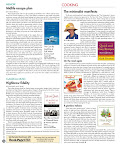March 21, 2008 -- Scientists who conducted the most comprehensive survey to date of New Zealand's Antarctic waters were surprised by the size of some specimens found, including jellyfish with 12-foot tentacles and 2-foot-wide starfish.
A 2,000-mile journey through the Ross Sea that ended Thursday has also potentially turned up several new species, including as many as eight new mollusks.
It's "exciting when you come across a new species," said Chris Jones, a fisheries scientist at the U.S. National Oceanic and Atmospheric Administration. "All the fish people go nuts about that -- but you have to take it with a grain of salt."
The finds must still be reviewed by experts to determine if they are in fact new, said Stu Hanchet, a fisheries scientist at New Zealand's National Institute of Water and Atmospheric Research.
But beyond the discovery of new species, scientists said the survey, the most comprehensive to date in the Ross Sea, turned up other surprises.
Hanchet singled out the discovery of "fields" of sea lilies that stretched for hundreds of yards across the ocean floor.
"Some of these big meadows of sea lilies I don't think anybody has seen before," Hanchet said.
Previously only small-scale scientific samplings have been staged in the Ross Sea.
The survey was part of the International Polar Year program involving 23 countries in 11 voyages to survey marine life and habitats around Antarctica. The program hopes to set benchmarks for determining the effects of global warming on Antarctica, researchers said.
Large sea spiders, jellyfish with 12-foot tentacles, huge sea snails and starfish the size of big food platters were found during a 50-day voyage, marine scientist Don Robertson said.
Cold temperatures, a small number of predators, high levels of oxygen in the sea water and even longevity could explain the size of some specimens, said Robertson, a scientist with NIWA.
Robertson added that of the 30,000 specimens collected, hundreds might turn out to be new species.
Stefano Schiaparelli, a mollusk specialist at Italy's National Antarctic Museum in Genoa, said he thought the find would yield at least eight new mollusks.
"This is a new brick in the wall of Antarctic knowledge," Schiaparelli said.
Ray Lilley, Associated Press










